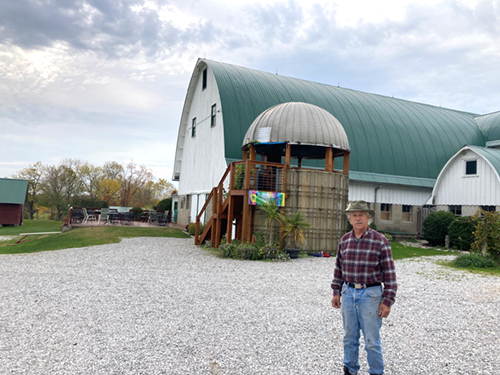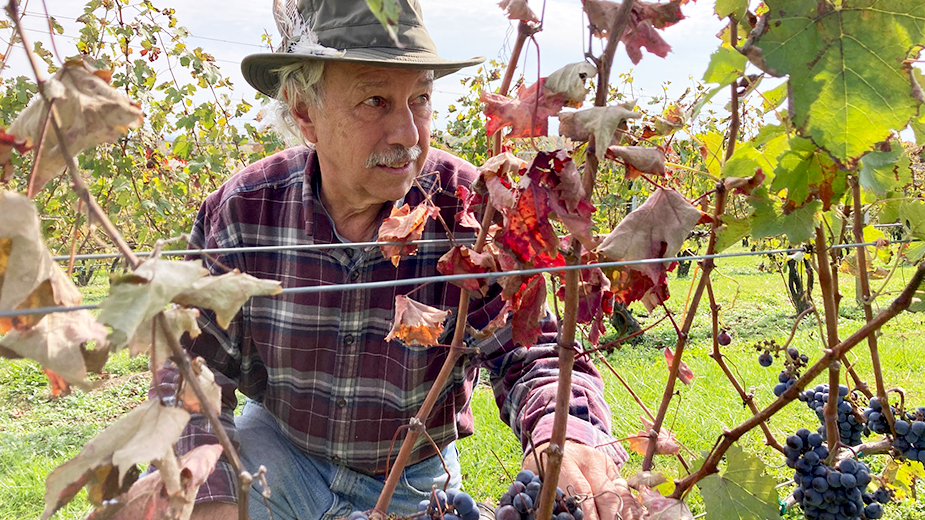YOUNGSTOWN, Ohio – This year’s grape harvest at northeastern Ohio vineyards produced a very low yield and a fruit quality that for most was average at best.
A spring frost laid the groundwork for a stunted crop, and a cool and rainy spell in late September delayed ripening and led to a higher incidence of rot.
But the news isn’t all bad, as results varied from field to field.
“We think of it as one industry, but there are locational differences,” says Andy Kirk, research specialist for Ohio State University’s Ohio Agricultural Research and Development Center in Kingsville.
“In the eastern side of Ashtabula County, the growers are disappointed in the juice. But from what I hear, in the Grand River Valley, they feel the quality is OK,” Kirk says.
The vast majority of northeastern Ohio grapes are grown in the Grand River Valley and elsewhere in northern Ashtabula County.
But variations in fruit quality can vary sharply from varietal to varietal – even at the same vineyard – from the shores of Lake Erie to the Mahoning Valley.
Despite the poor yield this year, there won’t be a shortage of Ohio wines in the region.
That’s because growers expect a bad year every decade or so and always keep about a year and a half’s worth of wine on hand to get them through the lean years, says Larry Laurello, owner of Laurello Vineyards.
Laurello cultivates 18 acres of grapes at his winery on state Route 307 in the Grand River Valley.
Maria Smith, viticulture outreach expert for The Ohio State University Extension office in Wooster, says yield “depended on where the vineyards are in northeastern Ohio and what varieties are produced.”
Growers in the Geneva/Madison area were particularly hard hit this year, with vines suffering from “extensive cold injury” during winter.
“From the growers I’ve talked with, yield loss was somewhere between 20% to more than 80%, depending on the vineyard site,” Smith says.
Several vineyard weather stations recorded temperatures around -14 or -15F in late January, which is cold enough to cause damage to most vinifera varieties, according to Smith. Vinifera are grapes of European origin that are grown locally for many Ohio wines.
In the sites where growers only lost around 20% of their yield, “It’s because their vines are on a slightly higher elevation,” Smith says. This is a region “where a few degrees can make a significant impact to survivability.”
LOCATION MATTERS
Rich Hill, owner-grower-winemaker of Laleure Vineyards near Middlefield, grows three acres of grapes on land about 20 miles south of the Grand River Valley wine region. Laleure’s inland location, as well as the terrain of his fields, produced a slightly different outcome.
Hill says his yield was way down this year, but the quality of the fruit is excellent.
The cold winter caused damage to some of his vines, but nothing permanent.
“It killed all of the [vine] trunks in my Sauvignon Blanc block, but luckily they were all grafted vines and are growing like crazy again,” Hill says. “There was no permanent damage, and we’ll have a nice crop next year.”
The spring frost also wreaked havoc at Laleure, killing buds that had just opened on red wine grapes such as Cabernet Franc, Pinot Noir and Chambourcin. “I wound up with maybe 50% of the crop,” Hill says.

Aside from the spring and fall weather problems, Laleure faced a different natural enemy that reduced his yield.
“There were raccoons in the lower part of my vineyard,” Hill says. “It explained why I was seeing grapes disappear. It was a triple whammy for me.”
Grapes ripen at varying rates depending on the varietal, which lengthens the harvest season.
Hill typically picks his Pinot Noir first, starting in mid-September. “I’ve been working to get the fruit to hang longer, which develops more sugar and makes acidity go down,” he says.
Next to be picked are the Vignoles, Bianca and Sauvignon Blanc grapes, which are used for white wines.
“I normally leave a few rows [unpicked] for ice wines,” he says, referring to the sweet regional specialty produced each spring from ripe fruit that is left to freeze on the vine.
The rows of Rieslings are harvested in early October, with the remaining reds between the second and third week of October.
After the grapes are crushed, the fermentation process begins.
Hill says he holds his wine in barrels for several years before bottling it.
“I won’t bottle [this year’s product] for two or three years,” he says. “Right now, we’re still drinking the 2019. I still have 17 barrels of 2019.”
After bottling, Hill lets the product “rest” for another six months, because “it does change during that time. You’ve got to let it calm down. It is a living thing.”
PLANNING AHEAD
The OARDC’s Kirk points out that Laleure’s grapes ripened a little sooner than those in northern Ashtabula County, which helped thwart damage from the late September rain.
“In Kingsville and Conneaut, they wound up with a lot of fruit that didn’t ripen,” Kirk says. “They had seven inches of rain in two days in the last week of September. At that point, the grapes fill up with water and start to split, and that environment is a lot more conducive to grape rot. We love to see no rain from September to mid-October.”
The weather is always a factor in any type of agriculture, and Kirk says growers plan for down years.
“We had a string of good years, so it’s not the end of the world,” he says of this year’s poor harvest. “You have to make as much wine as you can in the good years because in our climate, you’re going to have a bad year every five, six or seven years.”
The last time the harvest was this poor was in 2014, when the region was introduced to the meteorological phrase “polar vortex.”
Smith, of the OSU Extension office in Wooster, points out that the record yields of 2021 may have decreased the 2022 yield potential.
She cites other possible factors, including the warm final months of 2021, which could have deferred the cold-weather acclimation of grapes that is necessary for winter survival.
Sharp freeze-thaw swings in March “may have exacerbated tissue damage, and we had had a widespread freeze event in late April when grapes were right at the beginning of bud break that led to a loss in some yield-bearing shoots,” she says.
Finally, severe weather in early June coincided with bloom and that could have affected pollination and early fruit development, Smith says.
Laurello, of Laurello Vineyards, says for most of his crop, “there was so much loss that it was almost not even worth harvesting. Most of our vinifera got wiped out. For the Riesling, we typically get 10 tons, and we got one.”
One bright spot was his Vidal Blanc, a hybrid grape he uses for ice wine.
“It did well,” Laurello says. “Not as much fruit but it’s good quality. …[The yield] will be 70% of a normal year, but we suspect the quality will be better.”
When it comes to the vagaries of the weather and its effect on grapes, Laurello echoes the sentiments of Kirk.
“It’s just one of those years,” he says.
Pictured at top: Rich Hill, who is the owner, grower and winemaker of Laleure Vineyards near Middlefield, examines his vines.
